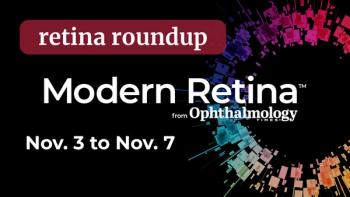
2017 mixed bag for retina specialists
Modern Retina Facebook Live from AAO: Drs. David Brown, Rishi Singh, Rick Spaide, and Charles Wykoff talk about the top stories in medical and surgical retina from the previous year, and what they're looking forward to hearing on the podium from Retina Subspecialty Day 2017.
By Michelle Dalton, ELS; Reviewed by Pravin Dugel, MD, and Charles Wykoff, MD
For retina specialists, 2017 was a year of highs and lows. Optical coherence tomography angiography (OCTA) and heads-up surgical systems were some highlights, but they were offset by disappointing clinical trial results for geographic atrophy (GA) and neovascular age-related macular degeneration (AMD).
Still, other innovations at the forefront this year included identifying biomarkers for retinal diseases, and a unanimous recommendation by an FDA Advisory Committee for approval of the first gene therapy to treat inherited retinal disorders.
Surgical, imaging innovations
For David R. Chow, MD, assistant professor, St. Michael’s Hospital, University of Toronto, and director, Toronto Retina Institute, using 3-D imaging is a revolutionary way of performing surgery. Like any other technology, the NGENUITY system (Alcon Laboratories) “has its growing pains, but the things we can do with it will allow us to perform surgery more safely,” he said.
Surgical innovations that seem to be taking hold this year include making internal limiting membrane flaps as a means to close posterior retinal detachments.
“Difficult macular hole surgery is kind of the sexy macular surgery talk du jour,” Dr. Chow said.
“OCTA started off as something that was not all that clinically useful, but now we’re doing it on almost half our patients,” said Richard Spaide, MD, of Vitreous Retina Macula Consultants of New York.
Dr. Spaide is also able to provide OCTA imaging to other specialties (including glaucoma). Using OCTA has led clinicians to realize glaucoma is a macular disease, he said.
Dr. Chow believes that within 5 years technology “will allow us to cover the posterior pole. We will be able to see with exquisite resolution all layers of the choroid, and do it in a noninvasive manner.”
To that end, Judy Kim, MD, professor of ophthalmology, Medical College of Wisconsin, said ultrawide-field imaging for diabetic retinopathy is comparable to the ETDRS, but needs only one image rather than seven, which is a “huge” benefit for patients.
“Peripheral lesions may be a biomarker for disease severity,” she said. “I tell my fellows if you can see more, you can treat more.”
OCTA is not the final frontier in imaging, Dr. Chow said.
“There is now a swept-source OCTA that’s heading to market,” he said.
Medical retina
The year has seen activity on the clinical trials landscape from dry and wet AMD to diabetic retinopathy and diabetic macular edema (DME), with 2018 promising to bring even more, said Charles Wykoff, MD, director of research, Retina Consultants of Houston, and elected Deputy Chair of Ophthalmology, Blanton Eye Institute, Houston Methodist Hospital.
Ophthotec’s pegpleranib (Fovista) anti-platelet-derived growth factor failed, which was a surprise,” said Pravin U. Dugel, MD, managing partner, Retinal Consultants of Arizona, Phoenix. “That changed our thinking as we realized it’s difficult to improve the efficacy for anti-vascular endothelial growth factor (VEGF).”
AMD treatments
Looking at opportunity in AMD treatments, “there’s going to be incremental improvement in efficacy,” said Dr. Dugel, adding the biggest thing in neovascular AMD this year is brolucizumab (Alcon Laboratories/Novartis).
David M. Brown, MD, clinical professor of ophthalmology, Baylor College of Medicine; vice-chair for research, Blanton Eye Institute, Houston Methodist Hospital, and partner at Retina Consultants of Houston, said the initial brolucizumab study results that showed patients can be maintained on a q12 week dose are “giving us hope that we may have an agent that lasts longer than our other agents do.”
Dr. Dugel also pointed to the DARPin class with Allergan’s abicipar as one to watch, and called RG7716 (Genentech/Roche) the “hot bispecific agent” currently being evaluated in the Avenue (efficacy) and Stairway (durability) studies.
Bayer/Regeneron’s nesvacumab is a combination therapy of angiopoietin 2 and aflibercept, which showed “great potential” in early studies, he said.
OPT-302 (Opthea) targets VEGF-C and VEGF-D and has reported favorable phase I/IIa results. Tissue factor (Iconic) was well tolerated in a phase I study, Dr. Dugel said.
Dry AMD
Dry AMD remains the greatest unmet need in his clinical practice, Dr. Wykoff said.
“Both the Spectri and Chroma phase III trials evaluating lampalizumab (Genentech) for the treatment of GA failed to meet their primary endpoint at 1 year,” he said.
“While this lack of efficacy at slowing GA growth was disappointing, detailed analyses of this combined dataset is anticipated to provide new phenotypic and genotypic insights into this complex disease,” Dr. Wykoff said. “In comparison, the positive efficacy signal, slowing GA growth by 28.6%, reported from the phase II FILLY trial targeting complement C3 with intravitreal injection of pegcetacoplan (Apellis) is encouraging for the field.”
Dr. Kim said the FILLY study was interesting because it marked the first time a phase II study showed a decrease in lesion growth. The patients who seemed to benefit most from the treatment also had increased risk of choroidal neovascularization membrane (CNVM), “so more needs to be learned about that,” she said.
Dr. Dugel agreed, saying the CNVM aspect “was a little surprising” and “a little confusing,” specifically when data also show those patients that had neovascularization actually did quite well. The full dataset may offer some clarification, he said.
Ophthotech is investigating avacincaptad pegol sodium (Zimura), a complement factor C5 inhibitor that Dr. Dugel said may have potential.
“Complement isn’t dead,” he said. “It depends on where we inhibit the complement.”
DME, retinopathy
During AAO Retina Subspecialty Day, attendees heard about the Diabetic Retinopathy Clinical Research Network’s Protocol U, which evaluated the combination of dexamethasone/ranibizumab to ranibizumab-alone for persistent central-involved DME following anti-VEGF therapy.
“Adding something that was supposed to block additional cytokines really had no effect,” Dr. Spaide said.
Dr. Wykoff uses OCT to guide his treatment strategies, and the anatomic results showed a significant difference in the combined arm.
Dr. Kim said results show there may not be the need to “chase fluid” as much as she has been.
Dr. Brown was impressed with the 6-month results of the phase I/II HULK study that evaluated suprachoroidal triamcinolone acetonide with and without aflibercept in DME. Results showed all eyes demonstrated anatomic improvement, with more than 65% showing a >50% reduction in excess central retinal thickness at all timepoints. There was a greater visual benefit in treatment-naïve eyes than in previously treated eyes (+8.5 and +1.1 letters, respectively).
“It looks like you might have a steroid option for DME without all the side effects we attribute to cataract and glaucoma,” he said.
Dr. Dugel added that anti-integrin therapy (Luminate, Allegro Ophthalmics) is “exciting. The DELMAR study has shown that patients who are resistant to anti-VEGF-A do the best.”
He also believes Merck’s investment of $37 million into KalVista to co-develop plasma kallikrein inhibitor KVD001 is noteworthy.
Aerpio “is basically saying we don’t want to treat DME, we want to prevent it from occurring” with AKB-9778, a Tie2 activator that inhibits VE-PTP and can be self-administered via a subcutaneous injection that has shown a two-step or greater decrease on the diabetic retinopathy severity scale in more than 10% of patients in both eyes within 3 months.
Dr. Wykoff is also excited about the potential to treat diabetic retinopathy.
“Ongoing trials assessing the value of interÃvening at the stage of nonproliferative diabetic retinopathy without DME-including the Panorama, DRCR W, and the TIME-2b trials-have the potential to change management strategies for diabetic retinopathy,” he said.
Gene therapy
Gene therapy and stem cells were also a highlight of the year, Dr. Chow said.
“They’re the ‘shining stars’ for the media and patients,” he said. “I can’t tell you how many times patients come in and ask if they can have stem cells.”
The success of Spark Therapeutics’ gene therapy for inherited retinal dystrophies has pushed others, including Regenxbio with RGX-314 for wet AMD and Adverum Biotechnologies with ADVM-022/032 for wet AMD, Dr. Brown said.
“You have two pathways in gene therapy,” Dr. Brown said. “In the first, you’re trying to fix something that’s missing that’s inherited. In the other, it’s: Can we make a viral vector make a factor create another anti-VEGF?”
Time will tell if the innovations being heralded in 2017 can translate into clinical relevance (and approval) down the road.
David M. Brown, MD
e: dmbmd@houstonretina.com
Dr. Brown is a consultant to and receives grant support from Genentech and Regeneron Pharmaceuticals.
David R. Chow, MD
e: davidrchow@me.com
Dr. Chow is a consultant to Alcon Laboratories, Allergan, Bausch + Lomb, DORC, and Katalyst, and receives lecture fees from Optovue.
Pravin U. Dugel, MD
e: pdugel@gmail.com
Dr. Dugel is a consultant to Aerpio, Alcon Laboratories, Allergan, Genentech, Ophthotech, Opthea, Regeneron, and Roche Diagnostics.
Judy Kim, MD
e: jekim@mcw.edu
Dr. Kim is a consultant to and/or receives grant support from Carl Zeiss Meditec, DRCR.net, Notal Vision, and Optos.
Richard Spaide, MD
e: rick.spaide@gmail.com
Dr. Spaide is a consultant to Topcon Medical Systems.
Charles Wykoff, MD
e: ccwmd@houstonretina.com
Dr. Wykoff is a consultant to and/or receives grant support from Apellis and Genentech.
Newsletter
Keep your retina practice on the forefront—subscribe for expert analysis and emerging trends in retinal disease management.
















































